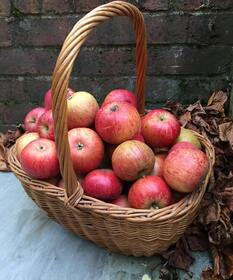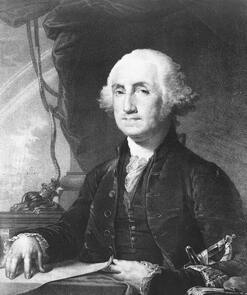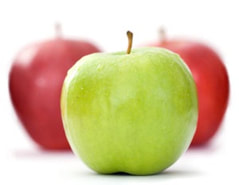Types
 7,500 varieties of apples are
grown throughout the world
7,500 varieties of apples are
grown throughout the world
- The apple variety ‘Red Delicious' is the America’s most popular with 62 million bushels harvested in 2005 (originally named “Hawkeye”, the variety originated in Peru, Iowa in 1870).
- The crabapple is the only apple native to North America.
- Apples come in all shades of reds, greens, and yellows.
- Apple blossom is the state flower of Michigan.
- 7,500 varieties of apples are grown throughout the world.
- 2,500 varieties of apples are grown in the United States.
- 100 varieties of apples are grown commercially in the United States.
- Apple varieties range in size from a little larger than a cherry to as large as a grapefruit.
History
 George Washington planted apple trees
George Washington planted apple trees
- The old saying, “An apple a day, keeps the doctor away.” This saying comes from an old English adage, “To eat an apple before going to bed, will make the doctor beg his bread.”
- The pilgrims planted the first United States apple trees in the Massachusetts Bay Colony.
- The apple tree originated in an area between the Caspian and the Black Sea.
- Apples were the favorite fruit of ancient Greeks and Romans.
- Europeans eat about 46 pounds of apples annually.
- The average size of a United States orchard is 50 acres.
- Charred apples have been found in prehistoric dwellings in Switzerland.
- Apples are the second most valuable fruit grown in the United States. Oranges are first.
- In colonial time, apples were called winter banana or melt-in-the-mouth.
- World's top apple producers are China, United States, Turkey, Poland and Italy.
- The top apple producing states are WA, NY, MI, PA, CA & VA.
- Newton Pippin apples were the first apples exported from America in 1768, some were sent to Benjamin Franklin in London.
- In 1730, the first apple nursery was opened in Flushing, New York.
- One of George Washington's hobbies was pruning his apple trees.
- America's longest-lived apple tree was reportedly planted in 1647 by Peter Stuyvesant in his Manhattan orchard and was still bearing fruit when a derailed train struck it in 1866.
- Archeologists have evidence that humans have been enjoying apples since at least 6500 B.C.
- The world's largest apple peel was created by Kathy Wafler Madison on October 16, 1976, in Rochester, NY. It was 172 feet, 4 inches long. She was 16 years old at the time.
- National Apple Month is the only national, generic apple promotion conducted in the United States. Founded in 1904 as National Apple Week, it was expanded in 1996 to a three-month promotional window from September through November.
- On August 21, 2007 the GoldRush apple was designated as the official Illinois’ state fruit. Apples are the state fruit of MN, NY, VT, WA & WV.
Health
 Apples are fat, sodium and cholesterol-free.
Apples are fat, sodium and cholesterol-free.
- Apples are fat, sodium, and cholesterol free.
- A medium apple is about 80 calories.
- Apples are a great source of the fiber pectin. One apple has five grams of fiber.
- The science of apple growing is called pomology.
- Don't peel your apple. Two-thirds of the fiber and lots of antioxidants are found in the peel. Antioxidants help to reduce damage to cells, which can trigger some diseases.
Trivia
- Apples are grown in all 50 states & grown commercially in 36 states
- 1 Semi-dwarf apple tree can produce 4-5 bushels of apples.
- 1 bushel of apples can produce two pounds of apples make one 9-inch pie
- Apples are a member of the rose family.
- The Lady or Api apple is one of the oldest varieties in existence.
- Apples harvested from an average tree can fill 20 boxes that weigh 42 pounds each.
- The largest apple picked weighed three pounds.
- Apple trees take four to five years to produce their first fruit.
- Most apples are still picked by hand in the fall.
- Apples are propagated by two methods: grafting or budding.
- Most apple blossoms are pink when they open but gradually fade to white.
- Some apple trees will grow over 40 feet high and live over 100 years.
- Most apples can be grown farther north than most other fruits, because they blossom late in spring, minimizing frost damage.
- It takes the energy from 50 leaves to produce one apple.
- Many growers use dwarf apple trees.
- Apples have five seed pockets or carpels. The number of seeds per carpel is determined by the vigor and health of the plant. Different varieties of apples will have different number of seeds.
- Apples ripen six to ten times faster at room temperature than if they were refrigerated.
- A peck of apples weight 10.5 pounds.
- A bushel of apples weights about 42 pounds and will yield 20-24 quarts of applesauce.
- It takes about 36 apples to create one gallon of apple cider.
- Apples account for 50 percent of the world's deciduous fruit tree production.
- Almost one out of every four apples harvested in the United States is exported.
- Many apples after harvesting and cleaning have commercial grade wax applied. Waxes are made from natural ingredients.
